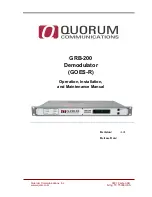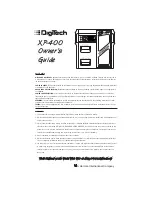
2
dc2091afa
DEMO MANUAL DC2091A
notes on test equipMent anD setup
•
Use high performance signal generators with fully
configurable differential I and Q outputs, such as the
Rohde & Schwarz SMJ100A vector signal generator or
equivalent.
•
Use narrow resolution bandwidth (RBW) and engage
video averaging on the spectrum analyzer to lower the
displayed average noise level (DANL) in order to improve
sensitivity and to increase dynamic range. The trade-off
is increased sweep time.
•
Spectrum analyzers can produce significant internal dis-
tortion products if they are overdriven. Generally, spectrum
analyzers are designed to operate at their best with about
–30dBm to –40dBm at their input filter or preselector.
Sufficient spectrum analyzer input attenuation should be
used to avoid saturating the instrument, but too much
attenuation reduces sensitivity and dynamic range.
•
Before taking measurements, the system performance
should be evaluated to ensure that:
1) clean input signals can be produced
2) the spectrum analyzer’s internal distortion is mini-
mized
3) the spectrum analyzer has enough dynamic range
and sensitivity
4) the system is accurately calibrated for power and
frequency.
•
Digital modulation often requires DC coupling and flat
frequency response. For best EVM performance with
complex modulation, the RC networks at the baseband
I/Q inputs are not required.
quick start proceDure
1. Remove the demonstration circuit from its protective
packaging in an ESD-safe working area.
2. Turn off the DC power supply as well as the baseband
and LO signal sources’ outputs.
3. Connect all test equipment as show in Figure 1.
4. Make sure jumper JP1 is installed and the jumper JP2
is installed at the 1-2 position.
5. Slowly increase the supply voltage to 3.3V. Do not
exceed 3.8V.
6. Turn on the baseband signal source. Set the baseband
common mode bias to 1.4V.
7. Verify the total V
CC
supply current is approximately
28mA. The demonstration circuit is now turned on
and is ready for measurements.
8. Turn on the output of the LO source and apply a
492.8MHz, 0dBm CW Signal.
9. Set the baseband signal source to provide a 100kHz,
200mV
P-P(DIFF)
baseband input signal. The I and Q
channels should be 90° shifted and set for lower
sideband selection.
10. Measure the modulator’s RF output on the Spectrum
Analyzer at 492.7MHz.
absolute MaxiMuM input ratings
Supply Voltage .........................................................3.8V
Common Mode Level of BBPI, BBMI,
and BBPQ, BBMQ ...................................................2V
LOL, LOC DC Voltage ............................................. ±0.1V
LOL, LOC Input Power .........................................20dBm
Voltage on Any Pin ...........................–0.3V to V
CC
+ 0.3V
T
JMAX
.................................................................... 150°C
Case Operating Temperature Range ....... –40°C to 105°C
Storage Temperature Range .................. –65°C to 150°C
CAUTION: ThIS PART IS SeNSITIve TO eleCTRO-
STATIC DISChARge (eSD). ObSeRve PROPeR eSD
PReCAUTIONS wheN hANDlINg The lTC5599.




















